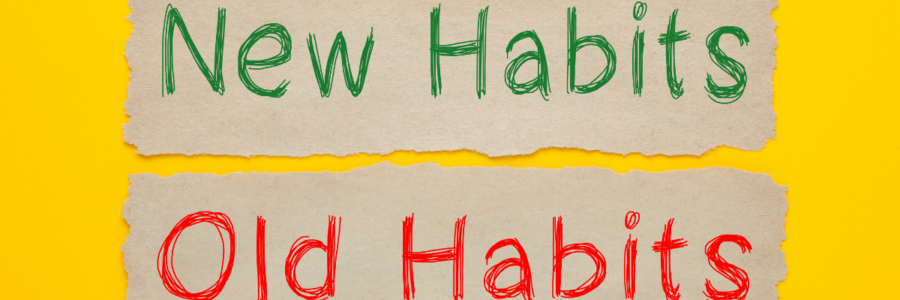How to change old habits and build new ones
Effective time management is challenging to undertake in itself. It can be overwhelming to learn time management techniques, implement different skill sets, and—perhaps the hardest of them all—change old habits.
In this blog post, you’ll learn all about habits and why it’s challenging to change your routines and build new ones. We’ll explore:
- Why habits are essential to time management and goal setting
- How habits are formed
- Why it’s hard to create a new habit
- How you can change old habits and build new ones
First, let’s explore the basics.
What are habits?
A habit is a routine or behavior that occurs subconsciously and automatically. Because it happens this way, we hardly notice most of our habits. So, what do habits have to do with time management or goal setting?
Habits matter and here’s why
Say you set a goal to be in a bodybuilding competition. A goal like this would require you to quit eating unhealthy foods, give up activities to ensure you dedicate enough time to the gym and get regular sleep. To achieve this goal, you’d need to spend a large portion of your time prepping healthy meals, working out, and eating at specific times, multiple times a day.
These are significant changes to one’s habits or daily routine.
Habits are, in essence, the way we spend our time every single day—from the mundane to the more critical and strategic aspects of our lives. Habits have the potential to either bring us closer to our goals or farther away. When we think about becoming the most effective version of ourselves, we acknowledge that how we are currently doing things does not serve us. A rejection of the status quo is required and will certainly and undoubtedly lead to some discomfort.
Before creating new habits that will help us reach our aspirations, we have first to understand how we form habits. Let’s take a look.
How are habits formed?
Take a seemingly simple task, for instance, like tying your shoes. This task consists of several small decisions (like making a bunny ear or deciding when to loop or pull that bunny ear) that make up one larger behavior or routine (shoelace tying). As a child, you may have relied on special rhymes to remember how to tie your shoes successfully. However, after years of repeated practice, you’ve committed each step—and accompanying decisions—to memory. Fast-forward to today; you’re a pro at tying laces. Instead of reciting, Bunny ears, bunny ears, playing by a tree, crisscrossed the tree, trying to catch me, you can now occupy your mind with other thoughts. The process has become automatic. This moment of automation is when a habit is born.
The basal ganglia, a small area in the center of your brain, plays a role in pattern recognition, motor control, and memory. Your prefrontal cortex is key to decision making. Together, the basal ganglia and prefrontal cortex help you identify, recall, and execute the necessary sequence to tie your shoes. As soon as you get to the point where a sequence is automated, your prefrontal cortex kicks into a sort of autopilot. By automating behaviors, our brain frees up mental space we can dedicate to other things.
Habit Loops
If we’re able to create habits so easily, why is it so hard to change them? Well, the answer sits with a little something called Habit Loops.
What are habit loops?
Charles Duhigg, a New York Times reporter and writer, published an insightful book called The Power of Habit, which explores the science behind the habits we create and recreate. This book explains that habits are formed through a habit loop, consisting of three parts: a cue, routine, and a reward.
- Cue: the cue is a signal or a trigger that incites a series of behaviors or actions. An example of a cue, for instance, is seeing a packet of cigarettes on your kitchen counter.
- Routine: the routines are the actions or behaviors that follow the cue. In the instance of seeing a packet of cigarettes (the cue), the routine would be to grab the pack of cigarettes, sit down outside, and smoke a cigarette.
- Reward: the reward is the outcome of the routine. It could be a feeling of relief or pleasure from smoking a cigarette, induced by your body’s absorption of nicotine. The reward is why a person will continue a series of behaviors—whether positive or negative.
This cycle—cue, routine, reward, rinse, and repeat—will eventually become a habit, occurring subconsciously, and automatically.
Why is it hard to change or break a habit?
When we think about creating a new habit or changing an old one, we can identify a few considerations that make it difficult. As we’ve just explored, habit loops create neural patterns in the brain which become automated. Changing a habit means undoing those neural patterns and getting rid of a reward. It is difficult to intentionally do away with a series of actions or behaviors that end in a reward—be it a feeling or result that makes you feel good. That’s incentive enough not to want to change.
But then there’s the actual routine itself. Changing a habit not only means potentially missing out on a reward but also changing your routine. It requires hard work and effort on one’s behalf. It could mean researching ways to replace old actions with new ones, implementing those actions, and relearning new behaviors. This can be very uncomfortable for many people. Let’s revisit the example of smoking, for instance.
Breaking your habit loop
Suppose you’re a smoker attempting to quit. You’d need to break the cue’s relationship (seeing a cigarette) with the routine (smoking a cigarette). In that case, you might find yourself fighting back cravings, suffering through nicotine withdrawal, and struggling to replace the routine that once gave you a feeling of reward. This process can be extremely uncomfortable and painful for many.
Some might develop plans to help them stay on course and mitigate the discomfort of changing a habit. This approach might include asking friends and family to keep them accountable, using nicotine patches to ease withdrawal, or finding activities to keep them occupied when cravings arise.
This process is challenging and requires determination and commitment on one’s part. It’s much easier to stick to the same routine even if the outcomes might not serve you.
This is true even for habits that don’t create a physiological dependency and applies to time management. It’s much easier to wait until the last day of a deadline to get work done than to commit to regularly getting work done. Why? Because the latter requires planning, commitment, and discipline. Not to mention that getting things right requires practice and iteration. So even if you do all the work of planning, creating a schedule, and committing to your plan, you might need to iterate on your plan before you get it right. It can all be—quite understandably—overwhelming.
Amygdala response
Remember our friend, the amygdala? The amygdala is the part of our brain responsible for our flight or fight response. And although there might not be anything perceivably threatening about changing a habit (or at least most habits), the amygdala may perceive discomfort as a threat. If you find yourself having various negative thoughts or associations with changing your habits, you’ll need to hack your amygdala and change your negative association to a positive one; this is why leaning into the reward aspect of the cycle is so important. More on that later.
Creating new habits
You now know why habits matter, how they’re formed, and why it’s hard to replace or change old habits. With all this new-found knowledge, it’s time to explore how you can replace old habits and build new, more effective ones.
Identify what needs to change
Think about your goal. What is it that you want to accomplish? Now, think about how you’re spending your time and the actions you take each day. Are these actions in line with what you want to change or improve?
A person who has smoked cigarettes for years might state their goal as, “I want to quit smoking.” Upon examining how they spend their day, they may realize that they take smoke breaks at work, pick up cigarettes at the gas station on the way to run errands, and smoke after dinner on the porch. These are specific actions or routines they engage in each day that take them further away from their goal. These are habits that must change in order to achieve their goal of becoming a non-smoker.
Once you identify how you spend your time and the actions or routines that you’d like to change, imagine yourself having achieved your goal. If you had quit smoking and were now a non-smoker, what would your day look like? Outline what your new lifestyle would look like day-to-day.
For example: I am a non-smoker.
- I go on runs without feeling sick
- I easily play with and keep up with my kids
- I am more present because I am not thinking about my next cigarette
This exercise will help you identify the actions that need to change and the positive outcome of that change in your life so you can then create a plan of action.
Create a plan
Habits are commitments in action. A habit is a series of actions you take to help you realize the commitment you made to yourself. To succeed, we suggest setting aside some time to think critically about the new habits you want to incorporate into your life and what it would look like to fail. Then, make some plans.
Take our previous smoking example, for instance. If you decided to quit smoking, what would it look like if you didn’t take action to change your habits? What would your life look like in six months to a year?
From there, make a plan. Outline the exact steps you will take to be successful in changing your habits. In the example of smoking, perhaps you’d outline that you’d use a daily nicotine patch or chewing gum when a craving arises. Then, take time to draft a plan of action if you fail to take the appropriate steps. If you were a smoker and had a relapse and smoked a cigarette, what would you do then? Identifying a Plan B, C, D, and so on is critical to getting back on track in the event of derailments.
Empower yourself
Make it easier to stick to your plans by making small changes in your environment that promote the plan’s adherence.
Let’s stick with the example of quitting cigarettes. In this position, a person could buy packs of nicotine gum and patches and keep them available throughout the house, car, bags, and jackets to help them deal with a future craving. This small change in their environment and planning helps reduce and eliminate the possibility of a slip-up.
Another example pertains to fitness. People who want to change their habits to include regular exercise might choose to go to bed in their gym attire. By doing so, they can eliminate obstacles and friction in their plans, making it easier to get up and go to the gym.
Get creative! Remember that you have the power to create a new habit and stick to it.
Aim for OK instead of perfect
Sometimes aiming for OK is better than striving for perfection, especially as it pertains to goals and habits. As you’ve seen, habit creation occurs over time—a cycle of cues, actions, and responses are repeated, becoming so ingrained in our brains that it happens on autopilot. To do something perfectly on autopilot would require thousands of hours of repetition.
Creating and breaking old habits is hard enough without the added pressure of doing it perfectly. So, if you find yourself setting the bar a bit too high, try to focus on making gradual progress instead, improving one day at a time. Sometimes it’s best to focus on gaining momentum instead of the finish line. Trust that you’ll get to where you need to be eventually, with small daily steps in the right direction.
Give yourself a reward
Remember, part of why the cycle of cue, routine, and reward is repeated until it becomes a habit because we like the reward. The positive association between the routine and reward is so strong that it automates an entirely new habit. So, in your pursuit of new habits, remember to continue rewarding yourself. Through positive association, you will also inform your amygdala that there is no threat, allowing the amygdala to shut off it’s response when faced with the new habit.
Here’s how you can incorporate reward into building new habits. Give yourself a small timeline to start. Perhaps it’s repeating the same habit over five days. At the end of the five days, give yourself a treat—maybe it’s a new book, new workout clothes, a massage, etc. Then set another timeline, and work to complete your habit again for another set of consecutive days, rewarding yourself at the end of that time frame. You might have a few false starts, but that’s OK—just keep trying. The point is to make momentum on your goal.
You’re on your way to building new habits
Ultimately, changing old habits and replacing them with new, more effective habits is a personal journey. You’ll have to discover what works best for you and how you can reach your goals as effectively as possible. Until then, we’ll be here to provide some helpful guidance, ideas, and best practices along the way.
Have your own suggestions on how to change old habits or create new ones? Share your thoughts in the comments section below!




